A Project of the Hudson River Estuary Program
Compiled and edited by Tom Lake, Consulting Naturalist
Love Our NY Lands
State Lands Belong to All of Us
All New Yorkers and visitors should be able to access, enjoy, and feel welcome on state lands. These lands belong to all of us, our families, and our neighbors. While enjoying these shared spaces, be respectful of other visitors. Share trails, treat people with kindness, and leave things as you found them for others to enjoy. All of us have a responsibility to protect State lands for future generations. For more information, visit: https://www.dec.ny.gov/outdoor/119881.html
Overview
Marauding striped bass in hot pursuit of acres of Atlantic menhaden has long been a defining autumn event in the lower estuary. The male harbor seal at Saugerties passed Day 800 in its ongoing saga of a marine mammal living comfortably in freshwater. Our 19th annual Day-in-the-Life of the Hudson and Harbor event hosted 64 schools and 2,750 students along 164 miles of the Hudson River estuary.
Highlight of the Week
 10/15 – Croton River, HRM 34: I was out kayaking twice this week in the tidal Croton River just inland from the railroad bridge. On the first occasion, I saw lots of splashes on the surface of the water—fish, I thought—but didn't see them. Today, however, I once again saw much commotion on the water and this time I could make out enormous schools of fish extending into Croton Marsh. I paddled over to what looked like yellowish-green submerged vegetation, but they were the tails of the fish. My kayak was suddenly surrounded by solid schools of 8-inch-long bluish-colored fish. 10/15 – Croton River, HRM 34: I was out kayaking twice this week in the tidal Croton River just inland from the railroad bridge. On the first occasion, I saw lots of splashes on the surface of the water—fish, I thought—but didn't see them. Today, however, I once again saw much commotion on the water and this time I could make out enormous schools of fish extending into Croton Marsh. I paddled over to what looked like yellowish-green submerged vegetation, but they were the tails of the fish. My kayak was suddenly surrounded by solid schools of 8-inch-long bluish-colored fish.
Something was chasing them, and they would take off creating wakes on the surface. And the noise! I paddled around in circles for a while watching the show. Another paddler saw the fish trapped in tide pools in the adjacent Inbuckie on low tide. I've been paddling on the Croton for more than 15 years, but never saw anything like this. [Marie had captured a moment —marauding striped bass chasing acres of Atlantic menhaden—that often defines the autumn season on the Hudson River. (Photo of Atlantic menhaden courtesy of Tom Lake)
- Marie Carter
[Inbuckie and Crawbuckie are colloquial names used to describe the mile of tidemarsh and shoreline between the mouth of the Croton River and Ossining (river miles 33-34). The origin of the names is hazy, but they have been commonly used by locals for well over a century. Crawbuckie is the low-tide beach on Croton Bay made famous in the 1960s and 70s by striped bass anglers, when catching one of any size was big news. Inbuckie is the adjacent tidemarsh inside, east of the railroad tracks. Prior to the early nineteenth century when the railroad bisected them, they were one. Tom Lake]
Natural History Entries
10/9 – Errata: A great gray owl photo was mistakenly paired with last week’s 10/7 Hook Mountain entry. The photo should have been a great horned owl.
- Tom Lake
10/9 – Bedford, HRM 35: Among the 108 south-migrating raptors today at the Bedford Audubon Chestnut Ridge Hawkwatch, sharp-shinned hawk was high count with 50; Cooper’s hawk was next with 37. Despite easterly winds, we had decent movement of both Cooper’s and sharp-shinned hawks. We also counted eight monarch butterflies.
- Richard Aracil, Abbey Butler, Karen Troche, Pedro Troche
 10/9 – Yonkers, HRM 18: The staff at the Sarah Lawrence Center for the Urban River at Beczak hosted the SLC Rotaract [Rotary] Club today for a look at Hudson River aquatic life. Across nine hauls of our seine, we caught five fish species, including Atlantic silversides, bay anchovies, white perch, young-of-year striped bass and a surprise, white catfish (Ameiurus catus). This was only the third of this species we had ever caught at Beczak. The first two occurred in 2010 and 2014. 10/9 – Yonkers, HRM 18: The staff at the Sarah Lawrence Center for the Urban River at Beczak hosted the SLC Rotaract [Rotary] Club today for a look at Hudson River aquatic life. Across nine hauls of our seine, we caught five fish species, including Atlantic silversides, bay anchovies, white perch, young-of-year striped bass and a surprise, white catfish (Ameiurus catus). This was only the third of this species we had ever caught at Beczak. The first two occurred in 2010 and 2014.
The river was 69 degrees Fahrenheit (F), the salinity was 7.5 parts-per-thousand (ppt), and the dissolved oxygen (DO) was 6.4 parts-per-million (ppm). (Photo of white catfish courtesy of Jason Muller)
- Jason Muller, Ishika Joshi, Michael Castro
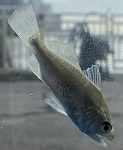 10/9 – Manhattan, HRM 2: Our Hudson River Park River Project staff, in checking our sampling and collection gear we deployed off Pier 40 in Hudson River Park, had an altogether lean but interesting catch. High count (6) went to juvenile black sea bass (20-74 millimeters (mm)). Two blue crabs were next (110-130 mm), along with our regular assemblage of shrimp, snails, ctenophores, and a moon jellyfish. The highlight (on 10/6), overshadowing the week’s catch, was a silver perch (Bairdiella chrysoura). It had been a long time since we caught one of these deceptive drums; they last appeared in River Project traps in 2003. (Photo of silver perch courtesy of Toland Kister) 10/9 – Manhattan, HRM 2: Our Hudson River Park River Project staff, in checking our sampling and collection gear we deployed off Pier 40 in Hudson River Park, had an altogether lean but interesting catch. High count (6) went to juvenile black sea bass (20-74 millimeters (mm)). Two blue crabs were next (110-130 mm), along with our regular assemblage of shrimp, snails, ctenophores, and a moon jellyfish. The highlight (on 10/6), overshadowing the week’s catch, was a silver perch (Bairdiella chrysoura). It had been a long time since we caught one of these deceptive drums; they last appeared in River Project traps in 2003. (Photo of silver perch courtesy of Toland Kister)
- Natalie Kim, Yaritza Morales, Olivia Radick, Helnea Kilburn, Abby Melissen
[One inch = 25.4 millimeters (mm)]
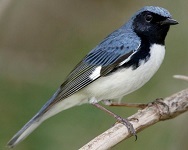 10/10 – Saratoga Springs, HRM 182: In early morning at the Bog Meadow Brook Nature Trail and Meadowbrook Preserve, we came upon two groups of rusty blackbirds, one group almost immediately. Thirty-four turkey vultures were roosting across the marsh. We passed them by and, when we came back that way, they were all airborne, joined by seven black vultures, three broad-winged hawks, and a red-tailed hawk. One bright breeding plumaged black-throated blue warbler was a highlight. Also notable were five woodpeckers, including red-bellied, downy, hairy, and pileated woodpecker, and a northern flicker. Across three hours we identified 78 taxa (species). (Photo of black-throated blue warbler courtesy of Lloyd Spitalnik) 10/10 – Saratoga Springs, HRM 182: In early morning at the Bog Meadow Brook Nature Trail and Meadowbrook Preserve, we came upon two groups of rusty blackbirds, one group almost immediately. Thirty-four turkey vultures were roosting across the marsh. We passed them by and, when we came back that way, they were all airborne, joined by seven black vultures, three broad-winged hawks, and a red-tailed hawk. One bright breeding plumaged black-throated blue warbler was a highlight. Also notable were five woodpeckers, including red-bellied, downy, hairy, and pileated woodpecker, and a northern flicker. Across three hours we identified 78 taxa (species). (Photo of black-throated blue warbler courtesy of Lloyd Spitalnik)
- Ron Harrower, John Hershey (Hudson-Mohawk Bird Club)
10/10 – Hook Mountain, HRM 31: We counted eleven south-migrating raptors at the Hook Mountain Hawkwatch today. Sharp-shinned hawk was high count with four. Bald eagle and osprey were next with two each. Non-raptor migrants included two ravens.
- Felicia Napier
10/11 – Bedford, HRM 35: Among the 83 south-migrating raptors today at the Bedford Audubon Chestnut Ridge Hawkwatch, sharp-shinned hawk was high count with 35; Cooper’s hawk was next with 33. Non-raptor migrants included three monarch butterflies, 47 cedar waxwings, and 36 American robins.
- Richard Aracil, Abbey Butler, Karen Troche, Pedro Troche
10/11 – Croton River, HRM 34: What a great day on the Croton River today; we had a super high tide, I assumed caused by the new moon plus being close to the equinox. The big pool at Van Cortlandt Manor had “balls” of circling herring; you could see them in the distance because sometimes their tails stuck out of the water. When I ghosted over them in my canoe, you could look down and see flashes of striped bass bellies below them. I assumed they were Atlantic menhaden, and the striped bass were feeding on them.
- Scott Craven
10/11 – Yonkers, HRM 18: The staff at the Sarah Lawrence Center for the Urban River at Beczak made five quick hauls of our seine this morning, and the catch was meager by our standards. High count went to moon jellyfish with 16; comb jellies were next at 14. The only fish were four Atlantic silverside along with a single blue crab. The river was 69 F, the salinity was 9.31 ppt, and the DO was 6.5 ppm.
- Jason Muller, Michael Castro, Sukaina Rashid
 10/12 – Little Stony Point, HRM 55: Long black windrows greeted us on the beach. A strong westerly breeze was pushing walls of Eurasian water chestnut seeds up on the beach with every swell. A ten-foot broad swath of the four-spined, peach pit-sized, seeds waited just off the beach for their turn. 10/12 – Little Stony Point, HRM 55: Long black windrows greeted us on the beach. A strong westerly breeze was pushing walls of Eurasian water chestnut seeds up on the beach with every swell. A ten-foot broad swath of the four-spined, peach pit-sized, seeds waited just off the beach for their turn.
There was nowhere to set our net. We walked upriver along the beach looking for any small opening and discovered that the rising tide was plowing tiderows of seeds right along with us. At the topmost end of the beach, we found a small opening that was destined to be covered within minutes. We hurriedly set our 30-foot seine and hustled it along with the swells filling in behind us. It was one and done.
We caught no migrating-to-the-sea fishes at all. The predictable white perch, opportunistic hunters when the surf is roily, were there, as well as tessellated darters. The river was 69 F, and the salinity was barely measurable.
- Tom Lake, T.R. Jackson, B.J. Jackson
[The seed of the Eurasian water chestnut (Trapa natans) has been described as a water “caltrop.” The original caltrop was a steel, multi-spiked medieval device used on battlefields as an area denial weapon, slowing down advancing enemy infantry. The countess thousands of “water caltrops” we encountered today effectively denied us the beach.
Tom Lake]
10/12 – Bedford, HRM 35: Among the 85 south-migrating raptors today at the Bedford Audubon Chestnut Ridge Hawkwatch, sharp-shinned hawk was high count with 39; Cooper’s hawk was next with 27. Red-shouldered hawks were being seen more frequently; today, we had a few (4) that were migrating. Non-raptor migrants included three monarch butterflies.
- Richard Aracil, Abbey Butler, Pedro Troche, Kevin McGrath
10/12 – Yonkers, HRM 18: The staff at the Sarah Lawrence Center for the Urban River at Beczak made the usual five hauls of our seine with markedly different results from yesterday. Gone were the moon jellyfish and comb jellies, making Atlantic silverside high count with 46 (80-100 mm). Other fish included mummichog and white perch. The river was 69 F, the salinity had dropped to 5.88 ppt, and the DO had risen to 7.38 ppm.
- Jason Muller, Bella Biane, Anna Mitchell, Ishika Joshi, Rebecca Wilson
10/12 – Manhattan, HRM 2: Hudson River Park’s River Project staff checked the sampling and collection gear that we deploy off Pier 40 in Hudson River Park. We had a blue crab, a handsome oyster toadfish (220 mm), and a rather large blackfish, or tautog (400 mm).
-Natalie Kim, Yaritza Morales
 10/13 – Albany County, HRM 140: While hiking with my grandsons in the Helderbergs, we came upon a beautiful 20-inch-long eastern milk snake (Lampropeltis triangulum triangulum). Its glistening scales indicated it must have recently shed its skin; its movements were very slow, likely preparing for hibernation. Sometimes confused with the venomous copperhead, the milk snake is harmless. A snake is always a surprise but this one was downright beautiful. (Photo of milk snake courtesy of Mario Meier) 10/13 – Albany County, HRM 140: While hiking with my grandsons in the Helderbergs, we came upon a beautiful 20-inch-long eastern milk snake (Lampropeltis triangulum triangulum). Its glistening scales indicated it must have recently shed its skin; its movements were very slow, likely preparing for hibernation. Sometimes confused with the venomous copperhead, the milk snake is harmless. A snake is always a surprise but this one was downright beautiful. (Photo of milk snake courtesy of Mario Meier)
- Mario Meier
[The milk snake’s markings, or bands, do not form hourglass shapes and their head is narrow, not diamond-shaped like pit vipers. Mario Meier]
10/13 – Saugerties, HRM 102: We saw the tagged male harbor seal (number 246) early this morning marking 800 days that he has been in or near Esopus Creek. A few observers have been of the opinion that there may be a second seal. However, I am convinced that it is just the one seal exhibiting different behaviors. Photos needed!
- Patrick Landewe
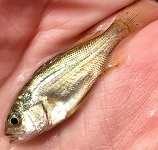 10/13 – Hudson River Watershed: Fish-of-the-Week for Week 122 is the silver perch (Bairdiella chrysoura), number 189 (of 235) on our watershed list of fishes. If you would like a copy of our list, e-mail - trlake7@aol.com. 10/13 – Hudson River Watershed: Fish-of-the-Week for Week 122 is the silver perch (Bairdiella chrysoura), number 189 (of 235) on our watershed list of fishes. If you would like a copy of our list, e-mail - trlake7@aol.com.
Silver perch is one of seven members of the drum family (Sciaenidae) in our watershed. Others include freshwater drum, weakfish, spot, northern kingfish, Atlantic croaker, and black drum. Except for the freshwater drum, an introduced freshwater fish, they are saltwater species found seasonally in the brackish reach of the estuary. Silver perch are a rather small marine “panfish” (maximum 12-inches) that feeds on small crustaceans such as Gammarus (amphipod), shrimp (Palaemon sp.), blue crabs (Callinectes sapidus), and mud crabs (Panopeidae). They outwardly appear similar to white perch (Morone americana) and are occasionally overlooked in catches. Some of the drums have a highly specialized swim bladder that serves as a sound-producing organ, earning them the colloquial name of “drum.” C. Lavett Smith (Photo of silver perch courtesy of Christina Tobitsch)
10/13 – Yonkers, HRM 18: The staff at the Sarah Lawrence Center for the Urban River at Beczak hosted our High School After-School Program today, making ten seine hauls searching for diversity of life in the river. The moon jellyfish were back; the other invertebrate was blue crab (25-90 mm). Fish included Atlantic silverside, white perch, and young-of-year striped bass. The river was 68 F, the salinity was 5.36 ppt, and the DO was 7.69 ppm.
- Jason Muller, Eli Caref, Ariel Pennington-Reyes, Michael Castro, Raven Vance
[Blue crab measurements (size) are taken in millimeters (mm) point-to-point across their carapace. Tom Lake]
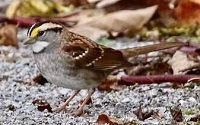 10/14 – Saratoga County, HRM 157: There was just one more day, after today, at the Vischer Ferry Nature Preserve until duck hunting would begin on 10/16. This morning, I checked out the long pond going west from the Main entrance while I still could. The only warblers I saw were yellow-rumped; there were probably slightly more ruby-crowned Kinglets. There was also a white-crowned sparrow and many white-throated sparrows. The best bird was a common gallinule, either a juvenile or adult non-breeding. There were also a few wood ducks and thirty green-winged teal. (Photo of white-throated sparrow courtesy of John Hershey) 10/14 – Saratoga County, HRM 157: There was just one more day, after today, at the Vischer Ferry Nature Preserve until duck hunting would begin on 10/16. This morning, I checked out the long pond going west from the Main entrance while I still could. The only warblers I saw were yellow-rumped; there were probably slightly more ruby-crowned Kinglets. There was also a white-crowned sparrow and many white-throated sparrows. The best bird was a common gallinule, either a juvenile or adult non-breeding. There were also a few wood ducks and thirty green-winged teal. (Photo of white-throated sparrow courtesy of John Hershey)
- John Hershey (Hudson-Mohawk Bird Club)
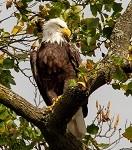 10/14 – Town of Poughkeepsie: At bald eagle nest NY62, the adult female had returned from her summer vacation (i.e., time off) following the fledgling of her single nestling. She has fledged 23 nestlings in 21 years. (Photo of bald eagle courtesy of Bob Rightmyer) 10/14 – Town of Poughkeepsie: At bald eagle nest NY62, the adult female had returned from her summer vacation (i.e., time off) following the fledgling of her single nestling. She has fledged 23 nestlings in 21 years. (Photo of bald eagle courtesy of Bob Rightmyer)
- Bob Rightmyer
10/14 – Beacon, HRM 61: In a four-hour fishing session, I caught and released two common carp that measured 13.5 and 15 inches long. I also lost another fish, probably a carp as well, due to a hook-pull. The water chestnut growth that routinely clogs the shoreline each summer had left.
- Bill Greene
10/14 – Cornwall Landing, HRM 57: Forty 4th-grade students from Willow Avenue Elementary joined us on the beach at Cornwall Landing in the shadow of Storm King Mountain, for our contribution to the 19th annual Day-in-the-Life of the Hudson and Harbor. We were one of 64 participating schools with 2,750 students along the river from Troy, at the head of tide, to Great Kills Gateway National Recreation Area in Staten Island.
Last year’s Day-in-the-Life, due to COVID, was held without students. That was a different river. The salinity was 2.5 ppt and that attracted Atlantic silverside, a brackish-water species. This year, there was not even a hint of salt due to a summer and fall of heavy storms.
Our catch was unremarkable, although through the eyes of the students, the fish were hundreds of silver jewels. As we slid the net up on the sand after each haul, out spilled scores of young-of-year striped bass, American shad, and blueback herring on their way to the sea. Gorgeous lavender-banded killifish were mixed in as well. The river was 67 F.
The highlight was our traditional Eel Race. I had brought two, foot-long, “trained racing eels” (Anguilla rostrata), that I had potted the day before. The race is best held on a sandy beach, preferably with a gentle slope to the water. In this case, two buckets (the race will support any number of eels in buckets), a quarter-full of water, were lined up a short distance apart, parallel to and about ten feet from the water’s edge. An American eel was placed in each.
A group of eager students are assigned to each entry. Competing groups can be any meaningful assemblage—in this case it was the two 4th grade classes. The eels are given honorary names like Eelie, Slimy, Snakey, or Fred, which makes cheering much easier. Today, the students named their eels “Gus 2.0” and “Jeff”.
At the chosen moment the buckets are slowly tipped over. The length of the race is a product of factors such as distance to travel, gradient of the beach, how well we watered the “racetrack” ahead of time, wind velocity, barometric pressure, enthusiasm of the cheering fans, and the individual eel’s competitive nature.
Jeff jumped out to a big lead as Gus 2.0 wallowed in a puddle in front of his bucket. Both the students and adults got into serious whooping and cheering. Perhaps showing a bit of overconfidence, Jeff just took his time. This gave Gus 2.0 time to climb out of the puddle, put on a true burst of eel-speed, and win handily.
- Tom Lake
10/14 – Bedford, HRM 35: Among the 103 south-migrating raptors today at the Bedford Audubon Chestnut Ridge Hawkwatch, sharp-shinned hawk was high count with 59; Cooper’s hawk was next with 23. We had a Falcon Trifecta today: American kestrel, merlin, and peregrine falcon. Non-raptor migrants included eleven monarch butterflies, 85 cedar waxwings, and a Baltimore oriole.
- Richard Aracil, Pedro Troche
10/14 – Yonkers, HRM 18: The staff and volunteers at the Sarah Lawrence Center for the Urban River at Beczak contributed to the 19th annual Day-in-the-Life of the Hudson and Harbor event. Our catch was light with just four fish, including one-each of Atlantic silverside, white perch, and young-of-year bay anchovy and striped bass. Overall high count was eight blue crab (80 mm). A small consolation from the salinity was a single sand shrimp (Crangon septemspinosa). The river was 69 F, the salinity was 6.65 ppt, and the DO was 6.72 ppm.
- Jason Muller, Eli Caref, Katie Lamboy, Bella Biane, Aubrey Baker, Ryan Palmer, Nina Hitchings
10/14 – Manhattan, HRM 2: Hudson River Park’s River Project staff checked the sampling and collection gear that we deploy off Pier 40 in Hudson River Park. On such a beautiful day, we were fortunate to be joined by students from New York City Museum School as we collected water quality and fish data for the 19th annual Day-in-the-Life of the Hudson and Harbor. When we pulled up our traps, we were greeted by a blue crab, a dazzling, young-of-the-year black sea bass (47.5 mm), and a serious-looking oyster toadfish (80 mm).
- Natalie Kim, Yaritza Morales
10/14 – Manhattan, New York City: Randall’s Island Park Alliance Staff hosted Manhattan’s Dwight School for our contribution to the 19th annual Day-in-the-Life of the Hudson and Harbor. Sixty seventh graders assisted us with eight hauls of our seine off the Water’s Edge Garden beach into the Harlem River to see what was home in the river today.
Not surprisingly, Atlantic silverside was high count with 100 fish. Others included young-of-year striped bass (115 mm), bluefish (180 mm), and three scup/porgy (105-120 mm). Among invertebrates, we caught six comb jellies and a blue crab. Salinity was 21.0 ppt, and the water temperature was 68 F.
- Chris Girgenti, Laura Velazquez, Jhanelle Mullings, Jackie Wu
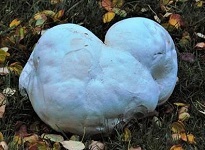 10/15 – Clifton Park, HRM 163: If you happen upon a “white ball” on someone’s lawn in early autumn, it is likely a giant puffball mushroom (Calvatia gigantea). My son spotted a uniquely shaped puffball in Clifton Park today; its circumference was 36 inches. At maturity, large specimens can contain seven trillion spores. (Photo of giant puffball mushroom courtesy of Mario Meier) 10/15 – Clifton Park, HRM 163: If you happen upon a “white ball” on someone’s lawn in early autumn, it is likely a giant puffball mushroom (Calvatia gigantea). My son spotted a uniquely shaped puffball in Clifton Park today; its circumference was 36 inches. At maturity, large specimens can contain seven trillion spores. (Photo of giant puffball mushroom courtesy of Mario Meier)
- Mario Meier
[Giant puffballs can be sliced like a loaf of round bread, and then lightly sautéed in a little butter and white wine. Tom Lake]
 10/15 – Kowawese, HRM 59: There was a stiff south wind and a strong chop on the river making wading an unsteady exercise. Still, we set our seine and braced ourselves into the current. There are days in autumn, when the estuary is flushing its young-of-year fishes to the sea, that a single haul is more than sufficient to discover what is home in that reach of the river. Today, a beautiful (80 F) Indian Summer’s Day, was one of those. 10/15 – Kowawese, HRM 59: There was a stiff south wind and a strong chop on the river making wading an unsteady exercise. Still, we set our seine and braced ourselves into the current. There are days in autumn, when the estuary is flushing its young-of-year fishes to the sea, that a single haul is more than sufficient to discover what is home in that reach of the river. Today, a beautiful (80 F) Indian Summer’s Day, was one of those.
As the seine neared the sand, we could see a mass of flashing silver: multitudes of young-of-year river herring. We opened the bag of the net in a few inches of water to lessen mortality and made a very quick and approximate assessment: five-hundred fish; ninety-percent blueback herring; ten-percent American shad. All were on their way to the sea. We quickly emptied the net freeing many if not most. Blueback herring continued to demonstrate the strength of their 2021-year class. The river had no salt and was 69 F. (Photo of blueback herring courtesy of Tom Lake)
- Tom Lake, A. Danforth
10/15 – Bedford, HRM 35: Among the 76 south-migrating raptors today at the Bedford Audubon Chestnut Ridge Hawkwatch, sharp-shinned hawk was high count with 47; Cooper’s hawk was next with 17. Turkey vulture (49) made a big push today. Non-raptor migrants included six monarch butterflies, 25 cedar waxwings, and eight eastern bluebirds.
- Tait Johansson, Pedro Troche, Tony Wilkinson
10/15 – Croton Point, RM 35: I was birding on Croton Point when I spotted a small (likely a male) red-tailed hawk sitting on the back of a park bench. As I watched, it launched itself upward into the lower branches of a nearby oak, and I realized that it was hunting a young gray squirrel. For the next fifteen minutes, the two played a game of cat-and-mouse among the limbs, the squirrel trying to keep the trunk between it and the hawk flapping and clambering after it. (This was all in complete silence.) Finally, the hawk flew back to the bench where it continued to look up at where the squirrel had hunkered down. Red-tails are usually ambush predators, not stalkers. I did not see the conclusion of the hunt, but the chase was a riveting sight.
- Joe Wallace
10/15 – Hook Mountain, HRM 31: We counted 105 south-migrating raptors at the Hook Mountain Hawkwatch today. Sharp-shinned hawk was high count with 86. Cooper’s hawk was next with ten. Many sharp-shinned hawks had full crops and five of them dove at our owl decoy. Three of them flew very low just south of the watch tangling with each other. Non-raptor migrants included 35 Canada geese.
- Ajit I. Antony, Jeff Berman, Liza Antony
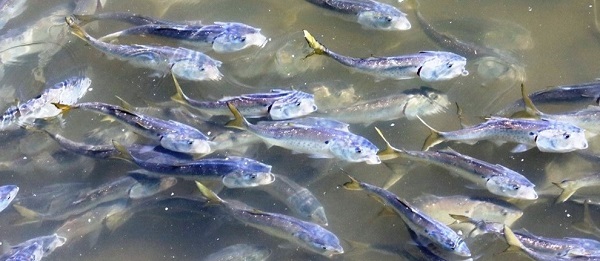
Hudson River Miles
The Hudson is measured north from Hudson River Mile 0 at the Battery at the southern tip of Manhattan. The George Washington Bridge is at HRM 12, the Tappan Zee 28, Bear Mountain 47, Beacon-Newburgh 62, Mid-Hudson 75, Kingston-Rhinecliff 95, Rip Van Winkle 114, and the Federal Dam at Troy, the head of tidewater, at 153. The tidal section of the Hudson constitutes a bit less than half the total distance – 315 miles – from Lake Tear of the Clouds to the Battery. Entries from points east and west in the watershed reference the corresponding river mile on the mainstem.
To Contribute Your Observations or to Subscribe
The Hudson River Almanac is compiled and edited by Tom Lake and emailed weekly by DEC's Hudson River Estuary Program. Share your observations by e-mailing them to trlake7@aol.com. To subscribe to the Almanac (or to unsubscribe), use the links on DEC's Hudson River Almanac or DEC Delivers web pages.
Discover New York State
The Conservationist, the award-winning, advertisement-free magazine focusing on New York State's great outdoors and natural resources. The Conservationist features stunning photography, informative articles and around-the-state coverage. Visit The Conservationist webpage for more information.
Useful Links
National Oceanic and Atmospheric Administration online tide and tidal current predictions are invaluable when planning Hudson River field trips. For real-time information on Hudson River tides, weather and water conditions from sixteen monitoring stations, visit the Hudson River Environmental Conditions Observing System website.
DEC's Smartphone app for iPhone and Android is now available at: New York Fishing, Hunting & Wildlife App.
|


 10/15 – Croton River, HRM 34: I was out kayaking twice this week in the tidal Croton River just inland from the railroad bridge. On the first occasion, I saw lots of splashes on the surface of the water—fish, I thought—but didn't see them. Today, however, I once again saw much commotion on the water and this time I could make out enormous schools of fish extending into Croton Marsh. I paddled over to what looked like yellowish-green submerged vegetation, but they were the tails of the fish. My kayak was suddenly surrounded by solid schools of 8-inch-long bluish-colored fish.
10/15 – Croton River, HRM 34: I was out kayaking twice this week in the tidal Croton River just inland from the railroad bridge. On the first occasion, I saw lots of splashes on the surface of the water—fish, I thought—but didn't see them. Today, however, I once again saw much commotion on the water and this time I could make out enormous schools of fish extending into Croton Marsh. I paddled over to what looked like yellowish-green submerged vegetation, but they were the tails of the fish. My kayak was suddenly surrounded by solid schools of 8-inch-long bluish-colored fish.  10/9 – Yonkers, HRM 18: The staff at the Sarah Lawrence Center for the Urban River at Beczak hosted the SLC Rotaract [Rotary] Club today for a look at Hudson River aquatic life. Across nine hauls of our seine, we caught five fish species, including Atlantic silversides, bay anchovies, white perch, young-of-year striped bass and a surprise, white catfish (Ameiurus catus). This was only the third of this species we had ever caught at Beczak. The first two occurred in 2010 and 2014.
10/9 – Yonkers, HRM 18: The staff at the Sarah Lawrence Center for the Urban River at Beczak hosted the SLC Rotaract [Rotary] Club today for a look at Hudson River aquatic life. Across nine hauls of our seine, we caught five fish species, including Atlantic silversides, bay anchovies, white perch, young-of-year striped bass and a surprise, white catfish (Ameiurus catus). This was only the third of this species we had ever caught at Beczak. The first two occurred in 2010 and 2014.  10/9 – Manhattan, HRM 2: Our Hudson River Park River Project staff, in checking our sampling and collection gear we deployed off Pier 40 in Hudson River Park, had an altogether lean but interesting catch. High count (6) went to juvenile black sea bass (20-74 millimeters (mm)). Two blue crabs were next (110-130 mm), along with our regular assemblage of shrimp, snails, ctenophores, and a moon jellyfish. The highlight (on 10/6), overshadowing the week’s catch, was a silver perch (Bairdiella chrysoura). It had been a long time since we caught one of these deceptive drums; they last appeared in River Project traps in 2003. (Photo of silver perch courtesy of Toland Kister)
10/9 – Manhattan, HRM 2: Our Hudson River Park River Project staff, in checking our sampling and collection gear we deployed off Pier 40 in Hudson River Park, had an altogether lean but interesting catch. High count (6) went to juvenile black sea bass (20-74 millimeters (mm)). Two blue crabs were next (110-130 mm), along with our regular assemblage of shrimp, snails, ctenophores, and a moon jellyfish. The highlight (on 10/6), overshadowing the week’s catch, was a silver perch (Bairdiella chrysoura). It had been a long time since we caught one of these deceptive drums; they last appeared in River Project traps in 2003. (Photo of silver perch courtesy of Toland Kister) 10/10 – Saratoga Springs, HRM 182: In early morning at the Bog Meadow Brook Nature Trail and Meadowbrook Preserve, we came upon two groups of rusty blackbirds, one group almost immediately. Thirty-four turkey vultures were roosting across the marsh. We passed them by and, when we came back that way, they were all airborne, joined by seven black vultures, three broad-winged hawks, and a red-tailed hawk. One bright breeding plumaged black-throated blue warbler was a highlight. Also notable were five woodpeckers, including red-bellied, downy, hairy, and pileated woodpecker, and a northern flicker. Across three hours we identified 78 taxa (species). (Photo of black-throated blue warbler courtesy of Lloyd Spitalnik)
10/10 – Saratoga Springs, HRM 182: In early morning at the Bog Meadow Brook Nature Trail and Meadowbrook Preserve, we came upon two groups of rusty blackbirds, one group almost immediately. Thirty-four turkey vultures were roosting across the marsh. We passed them by and, when we came back that way, they were all airborne, joined by seven black vultures, three broad-winged hawks, and a red-tailed hawk. One bright breeding plumaged black-throated blue warbler was a highlight. Also notable were five woodpeckers, including red-bellied, downy, hairy, and pileated woodpecker, and a northern flicker. Across three hours we identified 78 taxa (species). (Photo of black-throated blue warbler courtesy of Lloyd Spitalnik) 10/12 – Little Stony Point, HRM 55: Long black windrows greeted us on the beach. A strong westerly breeze was pushing walls of Eurasian water chestnut seeds up on the beach with every swell. A ten-foot broad swath of the four-spined, peach pit-sized, seeds waited just off the beach for their turn.
10/12 – Little Stony Point, HRM 55: Long black windrows greeted us on the beach. A strong westerly breeze was pushing walls of Eurasian water chestnut seeds up on the beach with every swell. A ten-foot broad swath of the four-spined, peach pit-sized, seeds waited just off the beach for their turn.  10/13 – Albany County, HRM 140: While hiking with my grandsons in the Helderbergs, we came upon a beautiful 20-inch-long eastern milk snake (Lampropeltis triangulum triangulum). Its glistening scales indicated it must have recently shed its skin; its movements were very slow, likely preparing for hibernation. Sometimes confused with the venomous copperhead, the milk snake is harmless. A snake is always a surprise but this one was downright beautiful. (Photo of milk snake courtesy of Mario Meier)
10/13 – Albany County, HRM 140: While hiking with my grandsons in the Helderbergs, we came upon a beautiful 20-inch-long eastern milk snake (Lampropeltis triangulum triangulum). Its glistening scales indicated it must have recently shed its skin; its movements were very slow, likely preparing for hibernation. Sometimes confused with the venomous copperhead, the milk snake is harmless. A snake is always a surprise but this one was downright beautiful. (Photo of milk snake courtesy of Mario Meier) 10/13 – Hudson River Watershed: Fish-of-the-Week for Week 122 is the silver perch (Bairdiella chrysoura), number 189 (of 235) on our watershed list of fishes. If you would like a copy of our list, e-mail -
10/13 – Hudson River Watershed: Fish-of-the-Week for Week 122 is the silver perch (Bairdiella chrysoura), number 189 (of 235) on our watershed list of fishes. If you would like a copy of our list, e-mail -  10/14 – Saratoga County, HRM 157: There was just one more day, after today, at the Vischer Ferry Nature Preserve until duck hunting would begin on 10/16. This morning, I checked out the long pond going west from the Main entrance while I still could. The only warblers I saw were yellow-rumped; there were probably slightly more ruby-crowned Kinglets. There was also a white-crowned sparrow and many white-throated sparrows. The best bird was a common gallinule, either a juvenile or adult non-breeding. There were also a few wood ducks and thirty green-winged teal. (Photo of white-throated sparrow courtesy of John Hershey)
10/14 – Saratoga County, HRM 157: There was just one more day, after today, at the Vischer Ferry Nature Preserve until duck hunting would begin on 10/16. This morning, I checked out the long pond going west from the Main entrance while I still could. The only warblers I saw were yellow-rumped; there were probably slightly more ruby-crowned Kinglets. There was also a white-crowned sparrow and many white-throated sparrows. The best bird was a common gallinule, either a juvenile or adult non-breeding. There were also a few wood ducks and thirty green-winged teal. (Photo of white-throated sparrow courtesy of John Hershey) 10/14 – Town of Poughkeepsie: At bald eagle nest NY62, the adult female had returned from her summer vacation (i.e., time off) following the fledgling of her single nestling. She has fledged 23 nestlings in 21 years. (Photo of bald eagle courtesy of Bob Rightmyer)
10/14 – Town of Poughkeepsie: At bald eagle nest NY62, the adult female had returned from her summer vacation (i.e., time off) following the fledgling of her single nestling. She has fledged 23 nestlings in 21 years. (Photo of bald eagle courtesy of Bob Rightmyer) 10/15 – Clifton Park, HRM 163: If you happen upon a “white ball” on someone’s lawn in early autumn, it is likely a giant puffball mushroom (Calvatia gigantea). My son spotted a uniquely shaped puffball in Clifton Park today; its circumference was 36 inches. At maturity, large specimens can contain seven trillion spores. (Photo of giant puffball mushroom courtesy of Mario Meier)
10/15 – Clifton Park, HRM 163: If you happen upon a “white ball” on someone’s lawn in early autumn, it is likely a giant puffball mushroom (Calvatia gigantea). My son spotted a uniquely shaped puffball in Clifton Park today; its circumference was 36 inches. At maturity, large specimens can contain seven trillion spores. (Photo of giant puffball mushroom courtesy of Mario Meier) 10/15 – Kowawese, HRM 59: There was a stiff south wind and a strong chop on the river making wading an unsteady exercise. Still, we set our seine and braced ourselves into the current. There are days in autumn, when the estuary is flushing its young-of-year fishes to the sea, that a single haul is more than sufficient to discover what is home in that reach of the river. Today, a beautiful (80 F) Indian Summer’s Day, was one of those.
10/15 – Kowawese, HRM 59: There was a stiff south wind and a strong chop on the river making wading an unsteady exercise. Still, we set our seine and braced ourselves into the current. There are days in autumn, when the estuary is flushing its young-of-year fishes to the sea, that a single haul is more than sufficient to discover what is home in that reach of the river. Today, a beautiful (80 F) Indian Summer’s Day, was one of those. 